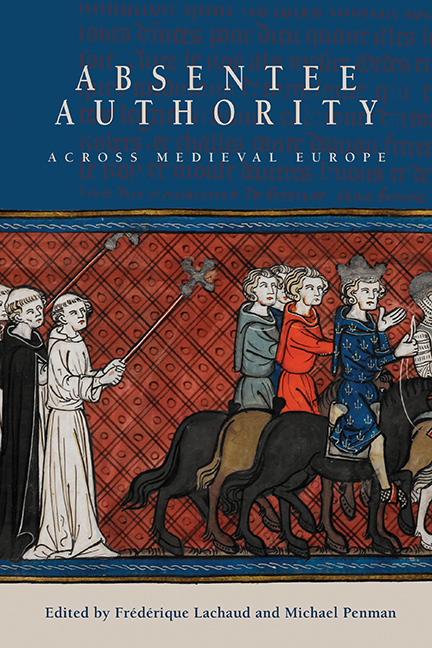Book contents
- Frontmatter
- Contents
- List of Illustrations
- List of Contributors
- Acknowledgements
- List of Abbreviations
- Introduction: Absentee Authority across Medieval Europe
- 1 Incarnating Authority, Exercising Authority: The Figure of the King in the Merovingian Era
- 2 ‘Ubi armae ibi princeps’: Medieval Emblematics as the Real Presence of the Prince
- 3 While the Bishop's Away …: Absentee Bishops of Parma during the Investiture Contest
- 4 An Inconceivable Absence: Usurpers and Illegitimate Rulers in the Genealogical Rolls of the Kings of England, from the Late Thirteenth to the Early Fifteenth Centuries
- 5 Local Loyalty and Absentee Authority in Thirteenth-Century Normandy: The Evidence of the Querimoniae Normannorum (1247)
- 6 Representation and Authority in Thirteenth-Century England and Gascony
- 7 Internal Exiles: Exclusion from the Fourteenth-Century English Court and Kingdom
- 8 ‘Si grant charté a Paris … par defaulté du roy’: Governmental Practice and the Customary Geography of the Absence and Presence of the King in France (1364–1525)
- 9 Was the Couple a Palliative to the Absence of the Prince? The Political Role and Influence of Margaret of Flanders during the Reign of Philip the Bold, Duke and Count of Burgundy (1384–1404)
- 10 Guardian – Lieutenant – Governor: Absentee Monarchy and Proxy Power in Scotland's Long Fourteenth Century
- 11 Absentee Authority in Late Medieval Iceland, as Viewed from the Literary Sources
- 12 Representatives of Kings and ‘Kings’ as Representatives: Authority and its Representation in Professional Groups in Late Medieval and Early Modern France – the Example of the King of Minstrels and of the King of Mercers
- Index
8 - ‘Si grant charté a Paris … par defaulté du roy’: Governmental Practice and the Customary Geography of the Absence and Presence of the King in France (1364–1525)
Published online by Cambridge University Press: 16 May 2018
- Frontmatter
- Contents
- List of Illustrations
- List of Contributors
- Acknowledgements
- List of Abbreviations
- Introduction: Absentee Authority across Medieval Europe
- 1 Incarnating Authority, Exercising Authority: The Figure of the King in the Merovingian Era
- 2 ‘Ubi armae ibi princeps’: Medieval Emblematics as the Real Presence of the Prince
- 3 While the Bishop's Away …: Absentee Bishops of Parma during the Investiture Contest
- 4 An Inconceivable Absence: Usurpers and Illegitimate Rulers in the Genealogical Rolls of the Kings of England, from the Late Thirteenth to the Early Fifteenth Centuries
- 5 Local Loyalty and Absentee Authority in Thirteenth-Century Normandy: The Evidence of the Querimoniae Normannorum (1247)
- 6 Representation and Authority in Thirteenth-Century England and Gascony
- 7 Internal Exiles: Exclusion from the Fourteenth-Century English Court and Kingdom
- 8 ‘Si grant charté a Paris … par defaulté du roy’: Governmental Practice and the Customary Geography of the Absence and Presence of the King in France (1364–1525)
- 9 Was the Couple a Palliative to the Absence of the Prince? The Political Role and Influence of Margaret of Flanders during the Reign of Philip the Bold, Duke and Count of Burgundy (1384–1404)
- 10 Guardian – Lieutenant – Governor: Absentee Monarchy and Proxy Power in Scotland's Long Fourteenth Century
- 11 Absentee Authority in Late Medieval Iceland, as Viewed from the Literary Sources
- 12 Representatives of Kings and ‘Kings’ as Representatives: Authority and its Representation in Professional Groups in Late Medieval and Early Modern France – the Example of the King of Minstrels and of the King of Mercers
- Index
Summary
In the later Middle Ages the power of the French king was personal. Its sacred character manifested itself in the contact the king established with his subjects; in practice, the physical presence of the king was a major political factor. The slow growth of administration did not displace this, but rather reinforced the king's ‘power in representation’. In this paper we shall study the absence of the king, but instead of examining political theory, we shall follow the king on his journeys and observe him through the reactions of public opinion. The itinerary of the king draws a kind of ‘customary map’, showing the proximity of power to its subjects: by default, the map suggests how distant power was, or how it was delegated. And on this map two scales overlap, a geographical one and a social.
The French kings could not cover the whole of the 400,000 km2 of their kingdom. They tended to stay in the ‘country’ of France, around Paris – which was their original domain. They visited other regions for specific purposes only. Ultimately, for many areas on the periphery of the kingdom, the absence of the king was the political norm. But absence also meant social distance: as princes, the kings maintained firm social barriers between themselves and their subjects. Between the reign of Charles V (1364–80) and that of Francis I (1515–47), these two aspects of royal residential practice changed significantly. In terms of geography, the royal space was reduced after the defeats of the first Hundred Years War (1337–75); during the second Hundred Years War (1411–53), it moved to a new area, the Loire Valley, under Charles VII (Map 1). Finally, from the reign of Charles VIII (1483–98) the kings had at their disposal a kingdom that was united and tightly held; it was from there that they were able to launch their conquest of the Italian principalities. Political stability and an expanding administrative machine allowed them to reduce their travels through France (Map 2). At the same time, the social distance between court and bourgeois increased: the king deserted the locations where he had been traditionally present, in particular Paris, his capital. How did the kings of France manage this transformation of the space they inhabited, and what were the political consequences?
- Type
- Chapter
- Information
- Absentee Authority across Medieval Europe , pp. 153 - 170Publisher: Boydell & BrewerPrint publication year: 2017
- 1
- Cited by

